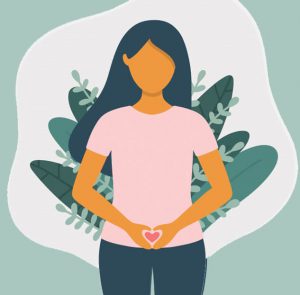The Infradian Rhythm is what many physicians around the world are calling a women’s biological superpower. It’s a monthly rhythm that regulates much of a women’s wellbeing, including their menstrual cycle, energy levels, metabolism, gut health (microbiome), mood, sex drive, eating habits, immune system, emotions and so much more.
Most people are familiar with the term circadian rhythm , our body’s 24-hour biological clock, and the banquet of reasons we should work with it for health harmony. But many aren’t as familiar with the very important rhythm that’s reserved only for menstruating women, called the infradian rhythm. Aligning lifestyle with this rhythm proves powerful and that’s where the term ‘superpower’ comes from, because it’s seen as an overall advantage.
The most exciting part is, when a women aligns her habits with her infradian rhythm, it delivers an almost instant and noticeable improvement to her wellbeing.
It’s also worth noting that disruptions to infradian rhythms can encourage varied health symptoms such as more erratic menstrual cycles, PMS, Endometriosis, PCOS, lowered immunity, mental health issues, weight loss resistance, fertility issues and more. Its no coincidence that all of these symptoms and issues are reportedly on the rise.
When women work with their unique rhythm, it is not a restrictive diet, it’s cyclic- method way of living, and should not be a stressful approach. My advice to anyone beginning a new routine is to start with 1 or 2 small changes and work your way through a list slowly.
This method is not only for women with hormone issues, it will benefit all menstruating women.
You may be interested to know that the US Women’s Soccer Team train according to their infradian cycle to optimise their performance with amazing results. Watch this space for more stories like this to emerge!
How can you work with your infradian rhythm?
The phases of your menstrual cycle dictate your infradian cycle, and there are 4 phases in total. Follicular, Ovulatory, Luteal and Menstrual. Each phase requires certain nutrients, exercise, and sleep habits to support what the body needs during the phase. You’ll hear me refer to the 1st half of the cycle being the Follicular and Ovulatory phases (the 2 weeks after your period), and the 2nd half of the cycle being the Luteal and Menstrual phases (the week before your period, and during your period).
The best way to monitor your infradian rhythm is by tracking your menstrual cycle. The first phase of your cycle begins 7 days after your first bleed, called the Follicular phase.
When you think about how you feel at certain times of the month, it makes sense to adjust how we live, and there’s clear science behind it also. Menstruating women were never meant to live the same way day in & out, with foods, exercise, and sleep.
Although the guide for a monthly cycle uses 7 days to form the start and end of each phase, your 4 phases don’t necessarily begin and end on any given day by the book. This is a general guide only. Your rhythm is unique and creates phases that slowly transition into each other, for approximately 1 week each, across the month.
From a women’s first period until her last, the infradian rhythm is present and governing the beat of every month. The more we work with our cycles, the better we will feel and be symptom free. N.B Synthetic hormones, such as oral contraption (birth control), cease ovulation and menstruation in the quest to prevent pregnancy. Therefore a natural infradian rhythm won’t exist when taking it.
Lets look at each phase of an infradian rhythm and some of the basic steps we can apply to support our health.
Follicular – Phase 1
Week 1 after your period.
What happening with your hormones? : Estrogen and progesterone are naturally on the rise. You may feel a lift in energy, wellbeing and drive. Your immune health is naturally stronger this week, and you have lower levels of cortisol (stress hormone) being produced.
What to eat: Foods to support the microbiome and liver are the focus- they further support progesterone levels and the metabolism of estrogen. If you can genetically metabolise caffeine, enjoy it in moderation during this phase.
N.B If you have the CYP1A2 gene , this determines your ability to metabolise caffeine and also estrogen via the liver, and its recommended that you choose low or no -caffeine alternatives as often as possible.
Exercise: During this phase, your energy levels are increasing, however your metabolism is naturally slower, therefore it’s recommended to enjoy moderately – timed classes (approx. 30 mins max) of cardio, resistance training and/or HIIT workouts as often as you like.
The exercise you do in the first half of your cycle will benefit your fitness levels all month.
This phase also delivers increased creativity and optimism and is the perfect time to dive into new projects.
Ovulatory – Phase 2
Week 2
What happening with your hormones?: Estrogen peaks, testosterone and progesterone are also rising. You may feel motivated and quite powerful during this phase. Although ovulation only occurs for 3 or 4 days in your cycle, the days surrounding ovulation support the ovulation process and it’s greatly beneficial to support them with the same lifestyle habits.
What to eat: Enjoy plenty of dietary fibre and antioxidants, low-starch carbohydrates, quality fats and protein intake to support liver detoxification of excess hormones and muscle recovery with workouts. Practitioner- grade supplements with high dose vitamin C and bioavailable B-complex are highly beneficial.
Best ways to move: Participate in anything high energy, if your energy feels good – you’ll win with running, sprinting & HIIT to enhance your stamina. The exercise you do in the first half of your cycle will benefit your fitness levels all month.
During this phase, your libido, social confidence, and energy levels are likely to be high and you feel more inspired.
If this phase description doesn’t resonate with you, there’s a chance you may not be ovulating. This is common with excess estrogen issues. A DUTCH test (Dried Urine Test for Comprehensive Hormones) is an easy, at – home test that can determine the level of each hormone in your body throughout the day. Including your cortisol levels. Read more about the DUTCH test here
Luteal – Phase 3
Week 3
Hormones: Progesterone is at its highest, cortisol is higher than before and your metabolism is slightly faster. Entering the 2nd half of your cycle. Many women experience PMS symptoms here that are relieved when they sync with their cycles.
What to eat: Eating regular meals that include a balance of complex carbs, plants, proteins, and fats will help balance blood sugars and alleviate cravings due to a faster metabolism. This is why important to include wholesome carbs here, as they’ll prevent blood-sugar dips and help you to produce serotonin to combat excess cortisol, as well as help limit cravings. Snack on baked sweet potato, and include brown rice and other wholesome carbs at mealtimes.
Include more calcium, omega-3, magnesium, and B-vitamins in your diet. Reduce cortisol-producing foods such as caffeine, alcohol, refined sugars, refined oils and excess salt.
Best ways to move: Light or moderate exercises like yoga, pilates, and low-intensity resistance training. High intensity workouts can aggravate cortisol and switch on the excess water & fat-storing hormones.
MENSTRUAL – Phase 4
Week 4
Hormones: Levels of estrogen and progesterone are naturally low. Many women feel the need to rest more during this week, therefore longer sleep durations are beneficial.
What to eat: Foods rich in Vitamin B’s, iron, omega-3, antioxidants, and magnesium. Enjoy plenty of colourful vegetables, fruits, healthy fats, complex carbs and organic proteins, while enjoying more relaxing herbal tea blends.
Avoid processed food, excess alcohol and caffeine to keep your blood sugar stable. Practitioner – grade supplements with high dose bioavailable nutrients also help.
Best ways to move and rest : During this phase, your energy levels are naturally low, so its important to rest more and move with gentle movements such as stretching, yoga, walks and plenty of sleep.
Monitoring your infradian rhythm is an excellent way to look into the biochemistry of your body; and when it comes to tailoring lifestyle and foods in consultation, this is one aspect that I take into consideration.
Every woman is different, so the changes they face during each cycle may also be different. Keeping a journal of your symptoms and moods for a few months can help to decipher your rhythm and identify any patterns; to gain better knowledge of what foods and exercises are best to include and to avoid, what symptoms to expect and how to improve your overall performance and mental health.
An expert guide in womens health and nutrition will give you clarity and symptom -relief with optimal foods and lifestyle choices. Do you feel ready to monitor your cycle and begin to align? Comment below and share with us. If you have any questions or you’re ready to work with me, contact us today.
Tracie Connor is an Accredited Nutritionist specialising in womens health, gut health, weight management and genetics (nutrigenomics).
Catch her regularly featured in the Sydney Morning Herald, Womens Health & Fitness Magazine, Huffington Post and on ABC Radio.




